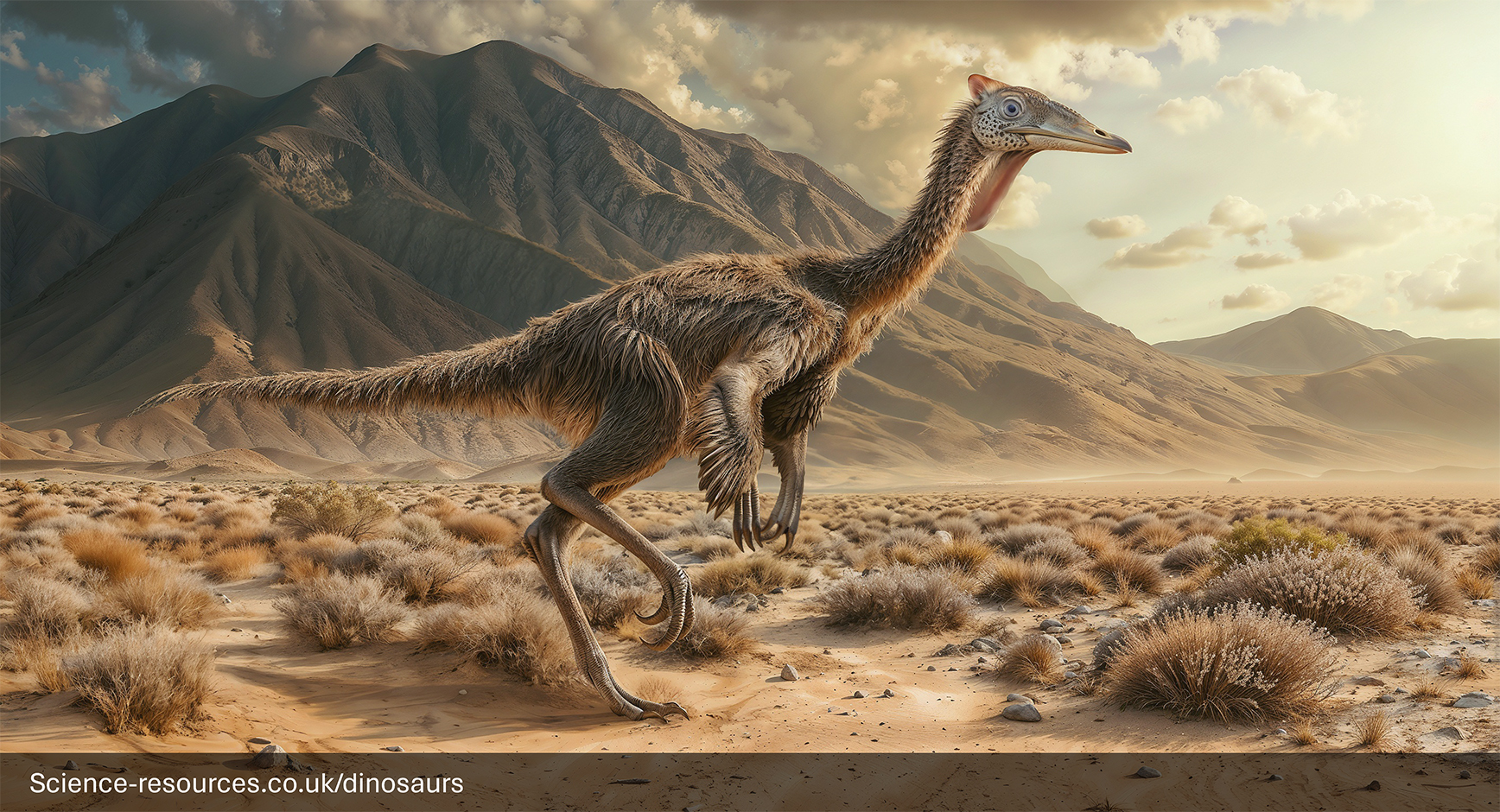Dinosaurs A:Z | P
You may also be intrested in: Free Dinosaur games
Dinosaurs: Pelecanimimus (Pelican Mimic)
You may also be intrested in: Free Dinosaur games
Pelecanimimus was a small, meat-eating dinosaur that lived during the Early Cretaceous period, about 127 to 121 million years ago. It belonged to a group of dinosaurs called Ornithomimids, which were known for their bird-like appearance. Length: Pelecanimimus could grow up to 2.5 meters (8.2 feet) long. Pelecanimimus had long hind limbs ending in three long clawed toes, making it a fast runner. It had a long neck, a tapered tail for balance, and a high ankle joint similar to modern-day ostriches. Unlike its relatives, Pelecanimimus had approximately 220 teeth, the most of any known carnivorous dinosaur. Evidence also suggests it may have had feathers. Generative AI Notification: Some elements of this image have been created or enhanced using AI technology. To find out how we create all our dinosaurs, click here. Pelecanimimus was a carnivore, which means it ate meat. Its many teeth helped it catch and eat its prey. Fossils of Pelecanimimus have been found in Spain. It lived in environments that provided plenty of food and shelter. • Name meaning: Pelecanimimus means "Pelican Mimic" because of its pelican-like features. • Ornithomimids: It was part of the Ornithomimid family, known as "Bird Mimics" due to their resemblance to flightless birds like ostriches. • Feathers: Scientists believe Pelecanimimus may have had feathers, although its relatives did not. • Fast runner: This dinosaur was built for speed, capable of sprinting up to 50 mph (80 kph), as fast as an ostrich. • Teeth: It had the most teeth of any carnivorous dinosaur, around 220! What is Pelecanimimus?
How big was Pelecanimimus?
Appearance
 Pelecanimimus
PelecanimimusWhat did Pelecanimimus eat?
Where did Pelecanimimus live?
Interesting facts
Pronounced: PEL-ih-can-ih-MIME-us


Pelecanimimus Facts
Diet: Carnivore (meat-eater)
Name Means: "Pelican Mimic"
Length: 6 ft. (2 meters)
Height: 3 ft. (1 meters)
Weight: unknown
Time: Early Cretaceous - 133 MYA
Habitat: River
Valleys
Fossils Found: Europe
Pelecanimimus belonged to a family of dinosaurs called Ornithomimids. This group is known for their bird-like appearance and fast running abilities. They are part of the order Theropoda, which includes other meat-eating dinosaurs. Other members include Ornithomimus, Gallimimus and Struthiomimus.
Pelecanimimus was a biped, meaning it walked on two legs. Its strong legs and lightweight body made it an excellent sprinter, well-suited for chasing prey and escaping predators.
Pelecanimimus had several unique features:
• Many teeth: It had approximately 220 teeth, unlike its relatives with toothless beaks.
• Feathers: Evidence suggests it may have had feathers, setting it apart from other Ornithomimids.
• Fast runner: It could run up to 50 mph (80 kph), making it one of the fastest dinosaurs.
Q1: What is a Pelicanimimus?
A1: Pelicanimimus was a small, bird-like dinosaur that lived during the Early Cretaceous period, around 125 million years ago. Its name means "pelican mimic" because of its long, narrow jaws.
Q2: How big was the Pelicanimimus?
A2: Pelicanimimus could grow up to 2 meters (6.6 feet) long and weighed around 20 kilograms (44 pounds).
Q3: What did Pelicanimimus eat?
A3: Pelicanimimus was likely an omnivore, meaning it ate both plants and small animals. It had more than 200 small teeth, which suggests it may have fed on fish, insects, and small amphibians.
Q4: How did Pelicanimimus move?
A4: Pelicanimimus was a fast and agile runner, moving on two legs. It had strong hind legs and a lightweight body, which helped it move quickly.
Q5: Where have Pelicanimimus fossils been found?
A5: Fossils of Pelicanimimus have been discovered in Spain, particularly in the Las Hoyas fossil site.
Q6: What makes Pelicanimimus unique among dinosaurs?
A6: Pelicanimimus is unique because of its large number of teeth and its bird-like features. It also had an ossified sternum and uncinate processes, which are features related to breathing like modern birds.
Q7: How do scientists learn about Pelicanimimus?
A7: Scientists study fossils, including bones and sometimes skin impressions, to learn about Pelicanimimus. They also use modern technology like CT scans to examine the fossils in detail.
Q8: Did Pelicanimimus live alone or in groups?
A8: It's not entirely clear, but some evidence suggests that Pelicanimimus may have lived in small groups or pairs.
Q9: What new discoveries have been made about Pelicanimimus?
A9: Recent studies have shown that Pelicanimimus had bird-like breathing mechanisms and features that suggest it was more bird-like than previously thought.
Q10: Why is Pelicanimimus important to study?
A10: Studying Pelicanimimus helps scientists understand more about the diversity of life during the Early Cretaceous period and how these amazing creatures adapted to their environments.
Which family of Dinosaurs did Pelecanimimus belong to?
How did Pelecanimimus move?
What were the unique features of Pelecanimimus?
Pelecanimimus FAQ
You may also be intrested in:
Tags: How big was Pelecanimimus, Pelecanimimus size, where does Pelecanimimus live, how tall are Pelecanimimus, what does Pelecanimimus mean, Pelecanimimus, Pelecanimimus facts